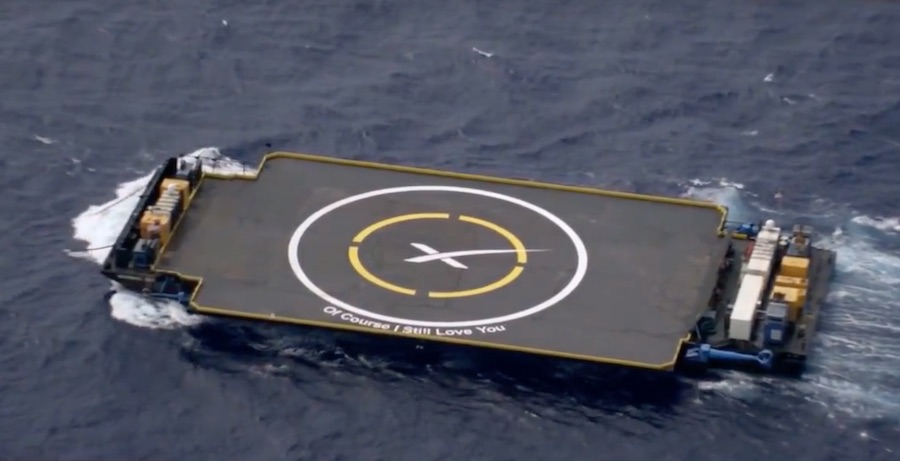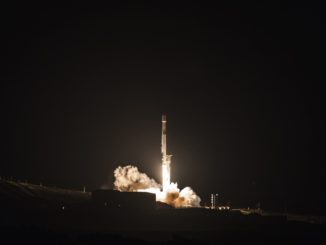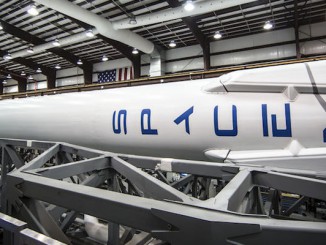
An electrical problem on SpaceX’s drone ship parked just off the coast of Cape Canaveral prompted SpaceX to scrub a Falcon 9 launch attempt early Friday, delaying the start of a resupply mission to the International Space Station by 24 hours.
The Falcon 9 countdown halted around 14 minutes prior to the rocket’s appointed launch time at 3:11 a.m. EDT (0711 GMT) Friday. SpaceX’s launch director announced over the countdown net that the company’s drone ship — the landing vessel where the Falcon 9’s first stage will attempt to land offshore — was unable to maintain power.
SpaceX was also evaluating a helium leak in a quick-disconnect interface at the launch pad, but officials cited the drone ship issue as the reason for Friday’s scrubbed launch attempt.
Teams lowered the Falcon 9 rocket horizontal to address the helium leak, while the football field-sized drone ship returned to Port Canaveral later Friday morning, presumably for servicing of the vessel’s electrical power system.
The drone ship, named “Of Course I Still Love You,” departed Port Canaveral a few hours later Friday afternoon to head back to the Falcon 9 booster’s targeted landing site 17 miles (28 kilometers) southeast of the rocket’s launch pad, or roughly due east of the easternmost point of Cape Canaveral.
A new launch attempt is scheduled for 2:48:58 a.m. EDT (0648:58 GMT) Saturday to begin a cargo resupply mission set to deliver 5,472 pounds (2,482 kilograms) of logistics, equipment and experiments to the International Space Station and its six-person crew.
With the one-day delay in the launch, the Dragon supply ship mounted atop the Falcon 9 rocket will reach the space station early Monday, not on Sunday as previously planned.
There is a 70 percent chance of favorable weather for Saturday’s predawn launch attempt, which is expected to the last launch opportunity available at Cape Canaveral until no earlier than May 12.
The Air Force-run Eastern Range, which provides range safety, support and security services for launches at Cape Canaveral, is unavailable due to a “stand-down” next week, according to Kenny Todd, NASA’s space station operations and integration manager.

For the first time, SpaceX scrubs a launch to ensure first stage recovery
SpaceX prefers to land its first stages and reuse the hardware, a practice it says reduces costs and eases the cadence of rocket production at the company’s headquarters in Hawthorne, California.
But SpaceX has given up on landing its Falcon 9 boosters before, most recently on a mission last year. Bad weather and rough seas prevented SpaceX’s drone ship from reaching a distant offshore landing site in the Atlantic Ocean for a launch in March 2018 carrying the Hispasat 30W-6 communications satellite.
SpaceX elected to proceed with the launch without recovering the first stage booster.
The landing location for the Falcon 9’s first stage on Saturday’s mission is unusual. Most resupply missions to the space station do not use the full capability of SpaceX’s Falcon 9 rocket, leaving ample leftover propellant for the first stage to reverse course and return to Cape Canaveral for an onshore landing.
But SpaceX’s Landing Zone 1, located at Cape Canaveral Air Force Station, is unavailable for this launch after the explosion April 20 of SpaceX’s Crew Dragon capsule during a ground test. Parts of the landing zone are still off-limits for safety reasons, according to Hans Koenigsmann, SpaceX’s vice president of build and flight reliability.
For heavier missions that require more of a boost from the first stage, SpaceX typically positions the drone ship hundreds of miles offshore, allowing the rocket to arc on a ballistic trajectory downrange, then slow down for landing without having to return to Florida.
The parking spot for the drone ship just off Florida’s Space Coast allows the Falcon 9 first stage to follow a return profile similar to the one originally planned to bring the booster back to Landing Zone 1.
A “close-in” drone ship landing has been accomplished before after a launch from Vandenberg Air Force Base in California in December.
Weather permitting, the timing of the Falcon 9’s launch in the predawn hours — due to the location of the space station’s orbit relative to the launch site — should allow observers along the beaches near Cape Canaveral to see the first stage descend toward the drone ship as it lights its engines for a series of boost-back, re-entry and landing burns.
Spectators may also hear sonic booms during the descent.
Email the author.
Follow Stephen Clark on Twitter: @StephenClark1.



